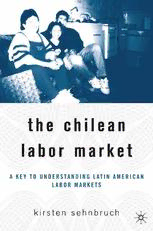
The Chilean Labor Market: A Key to Understanding Latin American Labor Markets PDF
Preview The Chilean Labor Market: A Key to Understanding Latin American Labor Markets
The Chilean Labor Market This page intentionally left blank The Chilean Labor Market A Key to Understanding Latin American Labor Markets by Kirsten Sehnbruch THECHILEANLABORMARKET:AKEYTOUNDERSTANDING LATINAMERICANLABORMARKETS © Kirsten Sehnbruch,2006. Softcover reprint of the hardcover 1st edition 2006 ISBN 978-1-4039-7230-9 All rights reserved.No part of this book may be used or reproduced in any manner whatsoever without written permission except in the case of brief quotations embodied in critical articles or reviews. First published in 2006 by PALGRAVE MACMILLAN™ 175 Fifth Avenue,New York,N.Y.10010 and Houndmills,Basingstoke,Hampshire,England RG21 6XS Companies and representatives throughout the world. PALGRAVE MACMILLAN is the global academic imprint of the Palgrave Macmillan division of St.Martin’s Press,LLC and of Palgrave Macmillan Ltd. Macmillan® is a registered trademark in the United States,United Kingdom and other countries.Palgrave is a registered trademark in the European Union and other countries. ISBN 978-1-349-53360-2 ISBN 978-1-4039-8364-0 (eBook) DOI 10.1057/9781403983640 Library of Congress Cataloging-in-Publication Data is available from the Library of Congress. A catalogue record for this book is available from the British Library. Design by Newgen Imaging Systems (P) Ltd.,Chennai,India. First edition:July 2006 10 9 8 7 6 5 4 3 2 1 To Gus, to my parents, Roswith and Helmut Sehnbruch, and to Chago, with love and gratitude for their presence in my life. This page intentionally left blank Contents List of Tables xiii List of Figures xv Abbreviations and Terms Specific to the Chilean Context xvii Acknowledgments xxi 1 Introduction: Model Performance or Precarious Employment? 3 2 Employment in the Development Context: The Contribution of the Capability Approach 21 1. Sen’s Capability Approach 22 1.1. Commodities and Entitlements 24 1.2. Functionings 24 1.3. Capabilities 26 2. Why the Capability Approach? 28 2.1. Basic Needs 28 2.2. Social Exclusion 29 2.3. Comparison of Approaches 30 3. Applications of the Capability Approach 33 4. The Labor Market in the Context of Development Thought 34 4.1. Labor Market Policies as a Fallout of Other Development Policies 34 4.2. The Labor Market as a Vehicle of Development and Expanded Capabilities 37 5. The Quality of Employment 40 5.1. Defining the Quality of Employment 40 5.2. Applying the Capability Approach to the Labor Market 42 6. Conclusions 44 viii ● Contents 3 The Never-Ending Story of Labor Market Reform 47 1. The Process of Labor Market Reform in Chile 48 2. The Labor Market before 1973 51 3. Labor Market Reforms under the Pinochet Administration 54 4. A Decade of Labor Market Reforms under Aylwin and Frei (1990–2000) 58 5. Legislative Reform under Lagos 65 6. Concluding Remarks 67 4 The Characteristics of Employment in Chile 73 1. Sources of Information 74 1.1. The National Employment Survey 74 1.2. The Employment Module of the National Household Survey, CASEN 76 1.3. Other Labor Market Surveys 77 1.4. The Politics of Information 79 2. Participation, Employment, Unemployment, and Wages 81 3. How Do We Look at the Data on the Chilean Labor Market? 83 4. The Characteristics of Employment in Chile 87 4.1. The Male and Female Workforce 87 4.2. Levels of Education 91 4.3. Age Structure 92 4.4. Economic Sector 92 4.5. Levels and Distribution of Income 93 4.6. Health, Pension, and Unemployment Insurance 94 4.7. Tenure and Job Rotation 101 4.8. Size of Employer 103 4.9. Vocational Training, Additional Employment, and Part-Time Work 103 4.10. Finding and Leaving Jobs 107 5. What the Data Does Not Tell Us 107 6. Conclusions so far 110 5 The Development of the Chilean Labor Market 113 1. Unemployment and Underemployment 114 2. The Changing Characteristics of Employment in Chile 117 Contents ● ix 3. The Effects of the 1998–1999 Economic Crisis 120 4. Employment Mobility Within the Chilean Labor Market 123 5. Employment, Poverty, and Income Distribution 129 6. Levels of Unionization 132 7. The Enforcement of Regulation 135 8. Conclusions 138 6 Legislation versus Practical Reality: Chile’s Unemployment Insurance 141 1. How Does the Unemployment Insurance Work? 143 2. Ideological and Theoretical Context 146 3. The Political Context of the Unemployment Insurance Legislation in Chile 150 4. Characteristics of the Employed and Unemployed 153 5. Simulation of the Unemployment Insurance 161 6. Evaluation of the Chilean Unemployment Insurance Scheme and Conclusions 164 7 Vocational Training: Missing the Opportunities 169 1. Theoretical Considerations and the Latin American Context 171 2. The Historical Context: SENCE’s Origins 175 3. Vocational Training under the Concertación: Reforming SENCE’s Statute 179 4. The Evolution of Vocational Training in Chile 182 4.1. Empirical Evidence on Vocational Training: The Official Data 182 4.2. The empirical Evidence on Vocational Training: Data from the National Household Survey (CASEN) 189 4.3. What the Data Does Not Tell Us and Other Conclusions so far 194 5. Targeted Vocational Training 196 5.1. Chile Joven 196 5.2. Apprenticeships 199 5.3. Emergency Employment and Vocational Training: ProEmpleo 201 6. Conclusions and Policy Recommendations 202
